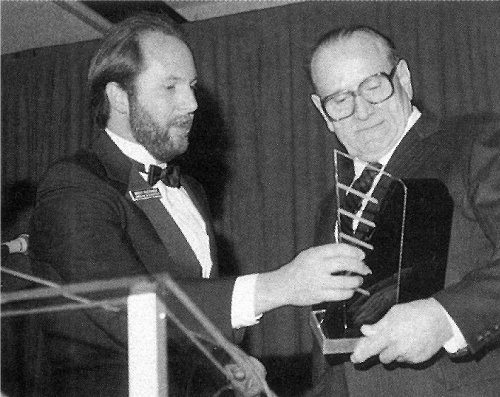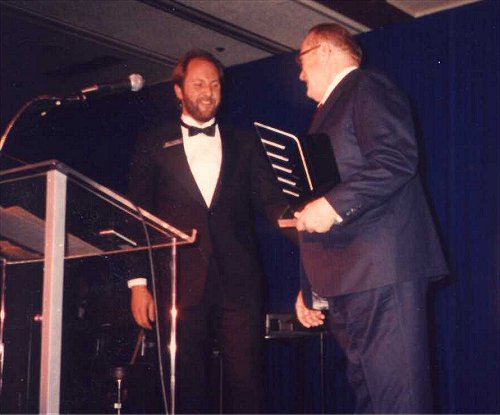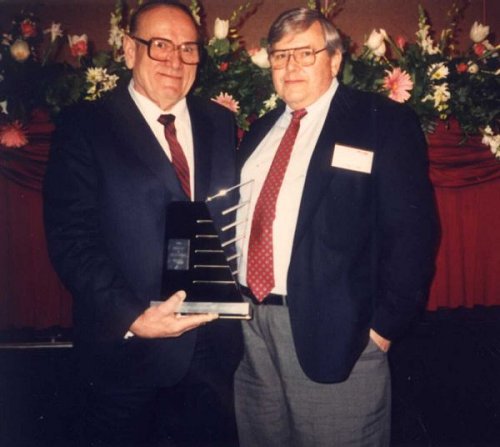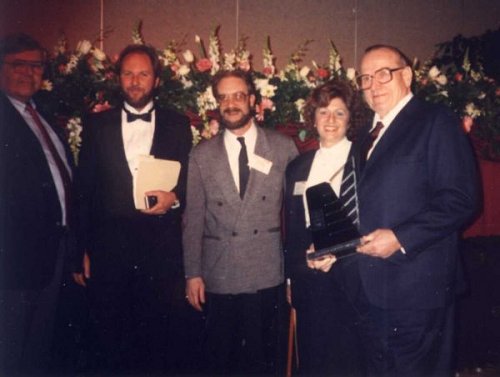Limousine & Chauffuer Magazine
Article in January/February 1986 Issue
A Conversation With Robert Peterson
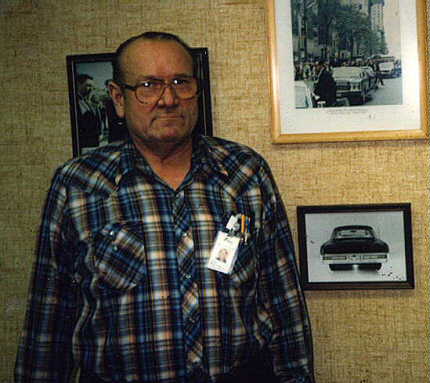 Known for the design and building of Lehmann-Peterson
limousines, Bob Peterson continues his tradition of
automotive craftsmanship at Moloney Manufacturing.
Known for the design and building of Lehmann-Peterson
limousines, Bob Peterson continues his tradition of
automotive craftsmanship at Moloney Manufacturing.
(More photos below)
In many ways, the era of the modern stretch-limousine began during the 'Sixties with the advent of Lincoln
conversions from Lehmann-Peterson in Chicago, IL. The original partners in the company were George Lehmann and Robert Peterson.
Peterson, a builder of Indianapolis race cars for a number of years, was asked by Lehmann to build a prototype limousine in 1963.
The two partners took their first stretch-Lincoln to the Ford Motor Company where it underwent a series of engineering and marketing
tests. After the tests were concluded, Ford agreed to sell Lehmann-Peterson limousines through its dealerships.
Despite the fact that there were relatively few commercial livery services during the 'Sixties, and the market
for limousines was much smaller during the Lehmann-Peterson era, the company built more than five hundred limousines between 1963 and
1970. Lehmann-Peterson introduced rear-facing seats and many other features found on limousines today. The company closed in 1970 in
the face of increasing government regulations affecting the transportation industry.
Limousine & Chauffeur: How and when did you get into the limousine business?
Peterson: I started in 1963. What happened was that I had been building some racing automobiles for use at
Indianapolis. George Lehmann, my partner, was a racing enthusiast. I had just rebuilt a Scarab automobile that had broken in three
pieces and he was quite impressed by what I had done on that car. He approached me and asked what I thought about building a limousine.
I had always been fond of the idea of building a limousine but never had a reason to do it. The final deal we came to was that I would
stretch the cars and he would provide the money. So we stretched a 1963 (Lincoln) as soon as we could lay our hands on one. We took it
up to the Ford Motor Company and showed it to them, They got all of the engineers together and had no less than sixty people looking at
the car. They were very cautious about building an automobile that was 500 pounds heavier than the standard automobile at the time,
because they wanted something structurally safe. They asked us to leave the car for some preliminary testing. Some years later we
found out that the Sales Department had taken the vehicle out and loaded it with as many guys as they could get in it. They drove
it over dips and bumps and got it launched up into the air but they were unable to break it, Then they asked if we would leave the
car for a serious evaluation and we satisfied them that the car was structurally sound. As a result, they participated with us
and we had a pleasant relationship for seven years. The reason that the company eventually closed was that, with all the new auto
safety rules being introduced at the time, Henry Ford thought it would be better if they didn't participate anymore, We didn't
feel that we were able to do an adequate amount of advertising without them.
Limousine & Chauffeur: Who else was building limousines in the Sixties?
Peterson: To my knowledge, the only cars being built were by Armbruster and those weren't really limousines.
They were airport-type cars. They were really a different type of vehicle. Ours were really sort of an elite vehicle. Coincidentally,
at the time I was designing rear-facing seats, Mercedes-Benz was doing the same thing in Europe. That came to light at the New York
Auto Show. They were claiming that they had the longest car but when they found that our cars were longer, they were gracious enough
to remove that from their advertising. Our car was almost twenty-one feet long.
Limousine & Chauffeur: Was Hess & Eisenhardt building limousines in that period?
Peterson: No. Hess & Eisenhardt was primarily building ambulances and that sort of thing.
Limousine & Chauffeur: Why did you choose Lincolns?
Peterson: George Lehmann was fond of Lincolns. I didn't really have a preference between Lincolns and
Cadillacs. I just wanted to stretch a car and make a really nice looking limousine. Now, I'm involved with Cadillacs. My project
here with Mr. Moloney is to build what we call the E/M car using a front-wheel drive Cadillac. We add eight inches in the passenger
compartment, and eight inches in the trunk. It makes a real nice vehicle.
Limousine & Chauffeur: What was the price range of your limousines in the Sixties?
Peterson: The base car was about six thousand dollars. We did the conversion for about seven thousand. If
you had three or more limousines, Ford would give you the car. That was one reason we worked with Lincolns.
Limousine & Chauffeur: Did you build a standard model or were the limousines primarily custom-built?
Peterson: We had what we called a standard model but, basically, our customers were wealthy people who wanted certain things
on their cars.
Limousine & Chauffeur: Were there many livery services buying your cars in the Sixties?
Peterson: Because of the subsidy program from Ford, there were about fifty cars that went into livery
service every year. Another thirty or forty limousines were bought by private individuals each year. The most cars we built in any one
year was one hundred and four in 1966. At the time, we were geared to build four a week so we could have built more but the market
wasn't that big.
Limousine & Chauffeur: Where was the plant located?
Peterson: On Armitage Street in Chicago. We had about sixteen thousand square feet.
Limousine & Chauffeur: What features did your limousines have?
Peterson: They had all of the accessories that we have now. One of the things we had that I don't see anymore was an auto
paging system so that the customer could carry a little transmitter with them to let the driver know when they would need the car.
Today that feature isn't really necessary.
Limousine & Chauffeur: Were many of your limousines convertibles?
Peterson: Not really. Lincoln built a convertible in those days and we converted two of them for Presidential use. They
were not armored, but they were set up to carry armoring added by the Secret Service.
Limousine & Chauffeur: Did you have to modify the engines to adequately power your limousines?
Peterson: No. You have to remember that these were relatively lightweight cars. Despite the added length, they were only
five hundred pounds heavier than a standard Lincoln.
Limousine & Chauffeur: After building racing cars for a number of years, how did you go about learning to build limousines?
Was there another make of limousine available for you to use as a model?
Peterson: I'm an advocate of starting from scratch. The reason I like to do it that way is that if you
start copying the designs of other people, you're prone to copying their mistakes too. It's better to do your own engineering and when
you get your own ideas sorted out the way you want them, then you can look at what other people have done and evaluate their ideas. I
think any engineer would do well to follow that course.
Limousine & Chauffeur: What do you think of as your contributions to the development of limousines from an
engineering standpoint?
Peterson: I think my contribution is in the area of building lightweight limousines. That really is the
keynote from the standpoint that if you make them too heavy, you need bigger tires, they get more expensive, and you're really not
doing a service to the customer. I also think the first priority of a coachbuilder is to build a quality car. Once you build a
car right, then you can look for ways to make it lighter and less expensive. That's what I'm still trying to do here at Moloney on
the E/M model. One thing we do here that none of the other builders do, to my knowledge, is to stamp our own quarter panels and
trunk lids for the front wheel drive Cadillac conversions. We also stamp panels for our limousines instead of cobbling them up out
of four or five different pieces. Our panels are much lighter and it makes our cars easier to work on.
Limousine & Chauffeur: How long have you been with Moloney Manufacturing?
Peterson: I've been with Mr. Moloney off and on for thirteen years. My position here at the Belmont Avenue facility is
Plant Manager, and my primary concern is the E/M car. We are planning to build between 2,000 and 2,500 of them in the coming year and
my personal feeling is that we'll probably build more than that.
Limousine & Chauffeur: Did any of your current employees work for you at Lehmann-Peterson?
Peterson: Yes. We have a man named Al Plaza who tests cars at the end of the production line to
make sure they have the proper quality just like he did at Lehmann-Peterson. We also have a man in the electrical department who was
with my company. We have a hundred and seventy-five employees here and they're not just people off the street. They are really "Old
World" craftsmen.
Limousine & Chauffeur: Is it true that a type of Russian limousine was modeled after a Lehmann-Peterson?
Peterson: Many years ago they bought a Lehmann-Peterson limousine and copied it. They don't really have a
market for limousines in Russia but I think they built them just to prove that they could do it. It was called a Zil, and they may
have just built one or they might maybe made more. Information doesn't really just flow out of Russia.
Limousine & Chauffeur: How were Lehmann-Peterson's marketed? Did you have distributors?
Peterson: One hundred percent of those cars were sold through the Ford Motor Company. They were sold
through Ford Dealers and those cars also has the Ford warranty on them. Incidentally, those limousines tended to have a lower warranty
cost than a standard Lincoln. That used to mystify both Ford and ourselves until we realized that we really poured over a limousine
when it was finished to find every possible defect and fix it. The same thing is true here where we build cars with the highest
quality possible. It has to be that way because, once you ship a car, your reputation goes with it.
Limousine & Chauffeur: What was the standard stretch-length of a Lehmann-Peterson?
Peterson: About thirty-six inches.
Limousine & Chauffeur: How do you feel about building today's longer limousines?
Peterson: There's certainly nothing unsafe about it. In our case, a lot of the specifications on size were
set by Ford.
Limousine & Chauffeur: Weren't the engineering designs basically yours though?
Peterson: Yes. I had carte blanche to do whatever I wanted to do. That even went to the point where if I did special
vehicles, and told the Ford people what I had done, the chief engineer would approve them.
Limousine & Chauffeur: What were some of those special projects?
Peterson: One was a Presidential armored limousine. That was a Ford project, in fact, Henry Ford owns that car to this day.
Limousine & Chauffeur: What do you see as future trends in limousine design?
Peterson: What we are trying to do here is to bring out the best quality possible and still keep cars affordable because
price is important. You can't produce something that you think is twice as good as the competition and expect to charge twice as much
for it. You try to build the best car in the market and then, if you can sell it at the lowest price, it behooves you to do so.
Limousine & Chauffeur: Did Lehmann-Peterson have an overseas market for limousines?
Peterson: There were cars built for kings and queens all over the world. For instance, the Royal Dutch household had one
or two, and there were many others, It was enjoyable to do those kinds of vehicles. I enjoy my work now too. I'm a car builder, and
I like to think of myself as being one of the best. I'm sure Mr. Moloney feels that way too or I wouldn't be working here.
Some photos of Robert Peterson at Moloney
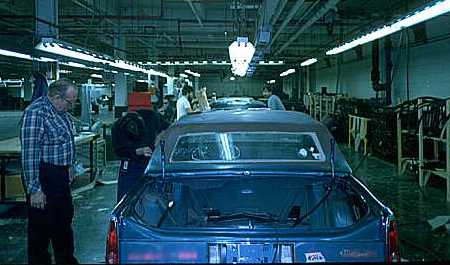
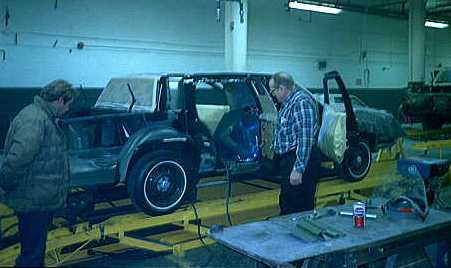
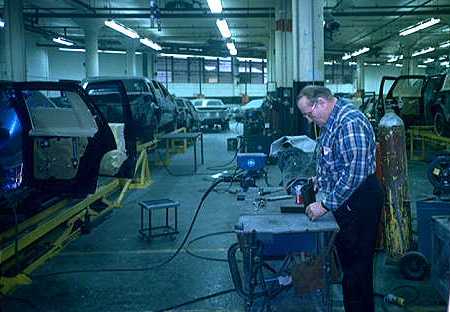
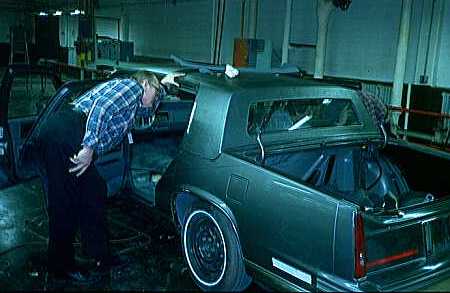
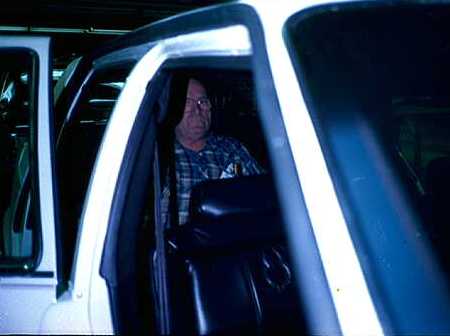
| 